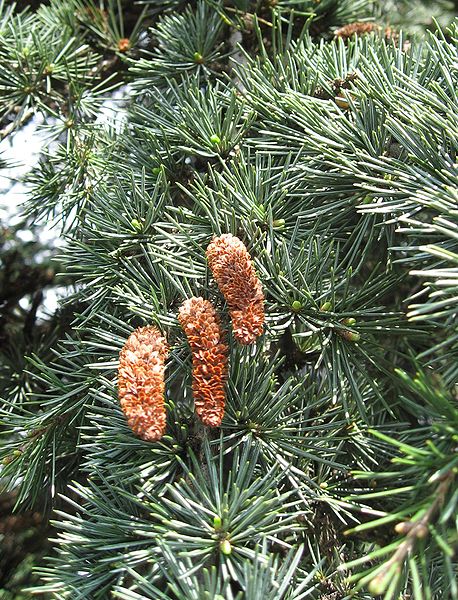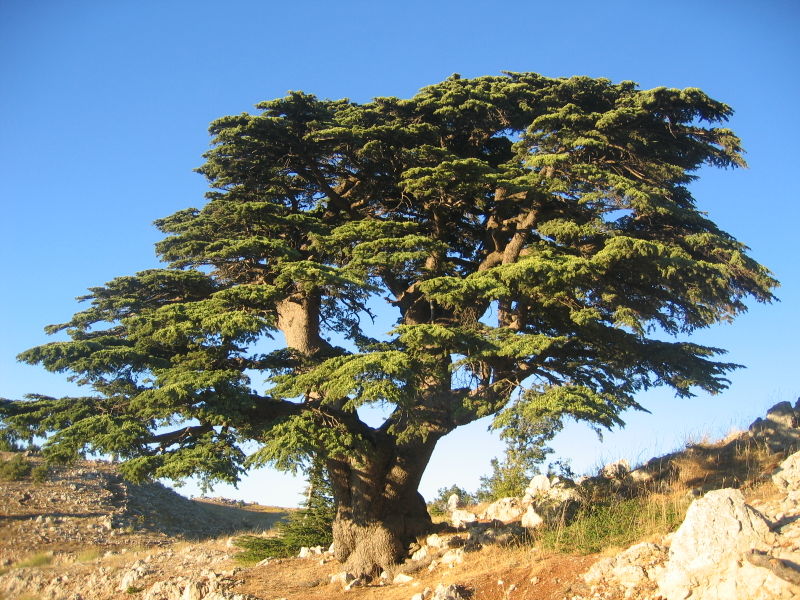Cedrus
Himalayan cedar ( Cedrus deodara )
The cedars ( Cedrus ) are a genus of flowering plants in the family (Pinaceae ).
- 4.1 cedar
- 4.2 cedarwood oil
- 5.1 Literature
- 5.2 Notes and references
Description
Cedar trees are large, evergreen trees that form a broad tree crown. They need plenty of sunlight to good growth and in comparison with other pine plants they come with relatively little rainfall from. The wood smells. The bark of young trees is smooth and gray. The small, egg-shaped buds are enveloped by a few scales. There are two types of branches: terminal long shoots with singly and spirally arranged on the branch needles - short shoots with bunches of needles. The dark green to blue-green needle-like leaves remain three to six years on the tree.
Cedar trees are monoecious getrenntgeschlechtig ( monoecious ), to a tree so are male and female cones. You are terminally on short shoots. The upright male cones are only about 5 cm, later up to 8 cm long; they are the largest in the family. The golden yellow pollen grains are wingless; the pollen takes place in autumn, not as in the other genera of the family in the spring. The upright, flowering female cones are ovoid, reddish, 1 to 1.5 cm long and consist of many seed scales. The closely overlapping seed scales are broader than long, woody with two ovules at its base. The small bracts can not be seen. From pollination to maturity need the pin one to two years. The upright, mature cones are ovoid to cylindrical, 5-10 cm long. The cones disintegrate at seed maturity and only the spindle remains on the branch. The large seeds are irregularly triangular, bright - to gray- brown and 11 to 16 mm long with a 15-25 mm wing, the wing has the same color as the seed.
The seedlings have eight to ten cotyledons ( cotyledons ).
Systematics and occurrence
Two of the three cedar species occur in the Mediterranean, a kind in the western Himalayas.
- The Atlas cedar (Cedrus atlantica ( Endl. ) Manetti ex Carrière ) occurs in Algeria and Morocco in the Atlas Mountains. It grows in a number of mutually insulated places at altitudes between 1,000 and 2,000 meters.
- The Himalayan cedar (. Cedrus deodara ( Roxb. ex Lamb) G. Don ) is found in various parts of the Himalayas in the Hindu Kush Eastern Afghanistan, in Pakistan and northwestern India ( Gharval - Himalaya ).
- The Lebanon cedar (Cedrus libani A. Rich. ): It is a small Asian Art It grows along the Mediterranean coast of Turkey to Lebanon, whose landmark it is. In addition, there is an isolated occurrence in Turkey near the Black Sea and in Cyprus. There are two varieties: Cedrus libani var libani
- The Cyprus cedar ( Cedrus libani var brevifolia Hook.f., Syn: Cedrus brevifolia ( Hook. f ) Elwes & A. Henry) is found only on the island of Cyprus. It grows in two small sub areas.
Relationships between species
All cedar species are closely related to each other. In particular, the growing in the Mediterranean species have many similarities, so that some authors have considered them together into a kind.
Because of the fossil record is known that cedar once populated other areas of the Mediterranean and also lying between the Mediterranean and the Himalayas region. It is therefore considered that the still occurring locations represent remnants of a once vast population. Today's existing locations in the dry climate limits the cedars cooler altitudes (often on north-facing slopes ) with sufficient rainfall. In the wild, all cedar species are threatened due to deforestation and overgrazing.
Pictures
Lebanon cedar (Cedrus libani ):
Cedar front of the castle Weinheim, planting year around 1720, height 23 m
Young stud
Young cones, close-up
Nearly Ripe and failing pins (2 and about 4 years old )
Himalayan cedar ( Cedrus deodara ):
Young tree.
Branch with needle-like leaves.
Branch with needle-like leaves.
Bark.
Use
Cedar
The wood of the cedar of Lebanon, contrary to popular belief, almost no smell, at best, a very weak, slightly aromatic smell of fresh wood is fixable. In contrast, the known as cedar generally colloquially as well as in the timber trade wood comes from some species of the cypress family Cupressaceae, which unlike real cedar of the genus Cedrus have a very strong, aromatic odor and a high percentage of essential oils. For example, the traded as cedar oil fragrance oil is a distillate of the Virginian juniper (Juniperus virginiana).
Everyday objects such as shoe trees, moth-proofing wood and cigar boxes are always made of the much more common wood in American parlance as Red Cedar (Giant Arborvitae Thuja plicata) designated type, all processed in the construction timbers under the generic term cedar also be derived from these cypress family.
The well-known under the name of Spanish cedar wood, however, comes from a deciduous tree of the West Indies Zedrele ( Cedrela odorata ) from the family of the mahogany family ( Meliaceae ). It is to regulate because of its pleasant smell and the ability to the humidity of the environment, often used for the inside lining of humidors.
In ancient cedars were easy to work because of her and very durable wood very popular in shipbuilding, for example, among the Phoenicians. In the 16th century cedar was a highly valued material, so had about the Venetian Council of Ten in 1556 diplomatic relations can play in order to get by the Patriarch of Damascus permission for felling of a cedar, the wood of the Council for the representative doors of the weapons collection should be used.
Cedarwood oil
Cedar oil was used in microscopy with light microscopes as immersion oil. It has, as well as glass, a refractive index of 1.5, and thus allows the microscope with high magnification. The force generated by the different in cover glass and gap light refraction total internal reflection can be avoided. Today, as a rule, synthetic oils are used.
According to a study by the Institute of Food Technology and the International Wood Protection Development Center has cedar extract (also from Thuja plicata) an antibacterial and antifungal effect. The substance β - thujaplicin was detected. Likewise, the activity against certain fungi on pine wood could be confirmed with the cedar wood extract.







